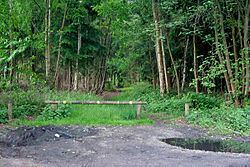Established pre-1600s Forest cover 750 acres (300 ha) | ||
 | ||
Website www.forestry.gov.uk/forestry/englandlincolnshirenoforeststaplefordwoods | ||
Stapleford Woods are an area of ancient woodland and forest in Stapleford, Lincolnshire, England. The boundary of the ancient woods marks the county boundary between Lincolnshire and Nottinghamshire.
Contents
- Map of Stapleford Wood United Kingdom
- HistoryEdit
- PresentEdit
- LeisureEdit
- The Real BadlandsEdit
- ControversyEdit
- References
Map of Stapleford Wood, United Kingdom
HistoryEdit
Left in ancient times to Trinity College, Cambridge, the 750 acres (300 ha) site was clear-felled during the early stages of World War I to supply local industry. Left unplanted between the wars, the grounds were used as a British Army camp and training grounds during World War II.
In September 1943 No. 239 Squadron RAF had moved to RAF Ayr to train as a night fighter unit, and re-equipped with the De Havilland Mosquito. It then moved to RAF West Raynham, Norfolk to join No. 100 (Bomber Support) Group, participating in night time operations against enemy Nazi-Luftwaffe fighters. On 27 October 1944 during fighter affiliation training with No. 49 Squadron RAF, a Mosquito piloted by F/Lt J.H.Roberts and accompanied by Flight Engineer Sgt. A.M.Ashcroft, stalled and crashed in the woods, with the immediate death of both pilot and passenger.
After the cessation of hostilities, in late 1945 the woods were bought by the newly formed Forestry Commission. Along with a lot of woodland within the River Trent valley, in the 1950s the site was extensively replanted with both Scots and Corsican pine, chosen to supply local industry.
PresentEdit
Now a managed working forest under the care of the Forestry Commission, surveys in 2004 found that the wood dated back at least 400 years, making it a designated ancient woodland. While many visitors are attracted by the Victorian era-plated Rhododendrons which are found throughout the wood at heights of up to 7 metres (23 ft), the Forestry Commission and North Kesteven council have agreed to a 50-year plan to restore the forest to its original broad-leaf tree state. Initial clearance of a 75 acres (30 ha) area yielded a resultant crop of purple flowering heather, which germinated from seeds that had been buried for over 70 years.
LeisureEdit
The Forestry Commission carpark grid reference SK861569, provides access to a marked .75 miles (1.21 km) circular walk, which takes 30-40mins at a leisurely pace to complete. The car park can be access from Coddington Lane, and is sign posted off of this road whilst travelling through the wood.
The Real BadlandsEdit
The woods were the main backdrop for the 2009 documentary film The Real Badlands produced by Current TV and Rockwood Pictures, by British filmmakers Tim Clark and Craig Ford. The film tells the story of a Newark on Trent couple (Simon Burgess and Susan Moran), who fed up with modern day life, quit their jobs, sell all of their possessions, and move into the woods.
The film was shot in the woods and Kelham, near Newark on Trent, during the summer and winter of 2008. After release the film was controversial, due to claims that the film was in fact a mockumentary. The filmmakers publicly denied these claims in a written statement read out live on Current TV, minutes after the film was broadcast.
ControversyEdit
In July 2012, the woods made national headlines after the Forestry Commission cleared undergrowth within the woods, which were said to be attracting large numbers of doggers, scaring families and ramblers. Police patrols by both Lincolnshire and Nottinghamshire Police have been increased, and carparks closed by North Kesteven at night with warning signs applied.
